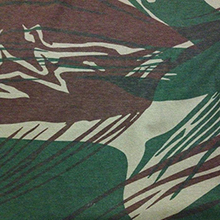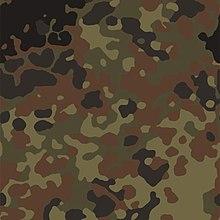Why Do Military Fabrics Have These Colors? And The Science Behind It.
2022-11-14 | Textile Fabric Knowledge
There are many ways a shoulder can disguise himself from enemies to avoid an encounter or to catch them by surprise. The most effective of them is camouflage, which makes soldiers and their equipment less visible.
Camouflage is a must when you need to conceal your position, go undetected long enough to spring an ambush on an enemy or slip past the enemy without them ever knowing you were there. You can use camouflage to do basically three things: vanish from sight, blend into your surroundings, or make yourself look like something you’re not.
Like many other great inventions, humans copied camouflage from animals. Most of the animal species have developed some sort of camouflage helping them to find food or hide from predators. The simplest camouflage technique is to match the background and blend in. This sort of camouflage you can easily discover yourself. Squirrels, deer, prairie dogs and other animals have brown fur to match tree trunks and soil at the ground level. Some animals went even further and change the color of their fur according to season. Some reptiles and sea creatures can change color in seconds to match their surroundings.
Humans also try to match the surroundings this is why all man-made camouflages are designed for a specific environment or task.
Below you can see some examples of the camouflage patterns
 |
 |
 |
|
Brushstroke Was used in Rhodesia, Zimbabwe and South Africa |
DBDU Was mostly used by the US Military, now similar patterns are used by many countries across the world |
Flecktarn The original German pattern was designed to use in European woodland terrain |
Material for camouflage can be of a single color, or it may have several colored parts mixed. We use this type of pattern to disrupt the viewer visually. The curved lines of the camouflage pattern help hide the outline of the body. Without camouflage, the enemy’s brain will readily recognize your distant silhouette as that of a human and not that of, say, a tree but when you look at a mottled camouflage in a matching environment, your brain naturally "connects" the lines of the colored pattern with the lines of the leaves, soil, trees, and shadows. This affects your perception and recognition of the person or object wearing this camouflage.
Camouflage material is colored with dull hues that match the colors of the surrounding environment. In jungle warfare, camouflage is typically green and brown, to match the forest landscape and dirt. In the desert, military forces use a range of tan and brown colors. Camouflage for snowy climates is colored in white and gray. To complete the disguise, soldiers paint their faces with colors matching the camouflage material.
Camouflage is a big part of military textile, which is why we can print numerous different camo patterns on our fabric. You can choose the color of the fabric when you order or make a custom one. Find the best military fabrics now.
Related News
Exploring the Versatility and Durability of Nylon 1000D Fabric
Nylon 1000D fabric is a versatile and durable textile that has found a wide range of applications across various industries. This high-performance fabric is known for its exceptional strength, resistance to wear and tear, and versatility, making it a popular choice for a wide range of products. In this article, we will explore the features, benefits, and applications of nylon 1000D fabric.
5 Ways Military Fabric Makes Your Life More Secure
Military fabrics are made for different purposes and are very versatile but the main purpose of those fabrics is to protect the owner from external threats. Here are 5 lifesaving abilities of military fabric.
